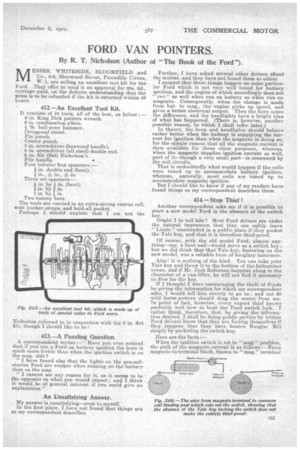FORD VAN POINTERS.
Page 27

Page 28

If you've noticed an error in this article please click here to report it so we can fix it.
By R. T. Nicholson (Author of "The Book of the Ford ").
ESSRS. WHITESIDE, BLOOMFIELD and Co., 8-9, Sherwood Street, Piccadilly Circus,
W. 1, are selling an excellent tool kit for the Ford. They offer to send it on approval for 28s. 6d., carriage paid, on the definite understanding that the price is to be refunded if the kit is returned within 48 hours.
A correspondent writes :—" Have you ever noticed that if you run a Ford on battery ignition the horn is much more feeble than when the ignition switch is on the mag. side ?
"I have found also that the lights on the pre-selfstarter Ford are weaker when running on the battery than on the mag.
" I cannot see any reason for it, as it seems to be the opposite to what you would expect ; and I think it would be of general interest if you could give an explanation.". Further, I have asked several other drivers about the matter, and they have not found them so either. I suspect that these things happen on some particular Ford which is not very well tuned for battery ignition, and the engine of which accordingly does not " rev." as well when run on battery as when run on magneto. Consequently, when the change is made from bat. to mag., the' engine picks up speed, and gives a better electrical output. Then the horn notes the difference, and the headlights have a bright idea of what has happened. (There is, however, another possible reason, to which I shall refer later.) In theory, the horn and headlights should behave rather better when the battery is supplying the current for ignition than when the magneto is doing so, for the simple reason that all the magneto current is then available for these other purposes, whereas, when the magneto supplies ignition current as well, part of it—though a very small part—is consumed by the coil circuits.
• That is undoubtedly what would happen if the coils were tuned up to accommodate battery ignition, whereas, naturally, most coils are tuned up to accommodate magneto ignition. But I should like to know if any of my readers have found things as my correspondent describes them.
Another correspondent asks me if it is possible to start a new model Ford in the absence of the switch key. Ought I to tell Min? Most Ford drivers are under the natural impression that they can safely leave " Lizzie " unattended in a public place if they pocket the Yale key, and that it is therefore thief-proof.
Of course, with the old model Ford, almost anything—say, a Bent nail—would serve a,s a switch key ; but we did think that that Yale key, featuring on the new model, was a reliable form of burglary insurance.
Alas ! it is nothing of the kind. You can take ydur Yale key and throw it to the bottom of the fathomless ocean, and if Mr. Jack Robinson happens along in the character of a van-lifter, he will not find it necessary to dive for the key. If I thought I were encouraging the theft of Fords by giving the information for which my correspondent asks, I would tell him sternly to go to ; and not 20 wild horse-powers should drag the secret from me. In point of fact, however, every expert thief knows perfectly well how to beat the Ford switch lock. I rather think, therefore, that, by giving the inform,tion desired, I shall be doing public service by letting Ford drivers know that they are fooling themselves if they suppose that they have beaten Burglar Bill simply by pocketing the switch key.
Here are the facts :— When the ignition switch is set to "mag." position, the path of the magneto current is as follows :—From magneto to terminal block, thence to "mag." terminal
of ignition switch, across to " coil " terminal, thence to common coil binding-post on engine side of dash, thence to the four coils in turn, and se on.
• But most of this wiring is used for the simple purpose of passing the magneto current through the ignition switch, it need not pass through the switch at all : it may go direct from magneto to the common coil binding-post on engine side of dash, and will do so if you run a wire direct from one to the other. Then you can start, and carry on, whatever the setting of the switch is.
Happily, it would take a thief a minute or two to establish this new connection, and while he was linking up he would risk being caught red-handed; so that the Yale key is some protection, after all, against theft.
Anyway, you now know how you (as an honest man) can start and carry on when you lose that key. "All very well," you say; "but,having thus started her, how am I going to stop the van I—as I shall not be able to switch off. And one must stop some time, if only for a drin—f or meals!" • My good man, there is your air-throttle control staring you in the face on the dash. Pull up the button, and the engine stops.
• All of which goes to show that there is no such thing as beating the thief. The best you can do is te make his job difficult for him.
































